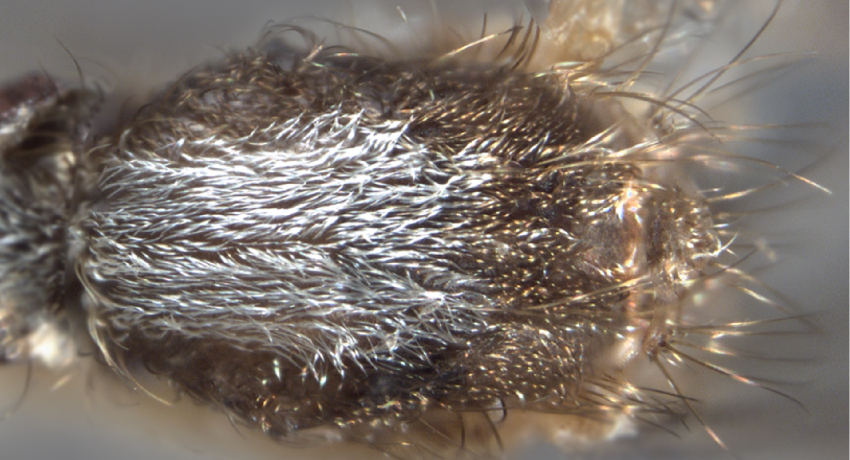NEARCTIC REGION
Informal name: Infirm American Pointy Mosquito
Etymology: not stated [weaken, diminish, be ill (L)]
Aedes infirmatus is one of 23 species assigned to the Ochlerotatus Group. Its distribution is limited to woodland environments in Honduras, Mexico and the southern United States. It is a competent vector of several important arboviruses.
Type locality: Baton Rouge, Louisiana, United States
Type depository: Type non-existent (NE)
DIAGNOSTIC CHARACTERS (Click photos to view; mouse over and click large photo to zoom in.)
ADULT (illustrated): Head: Proboscis entirely dark-scaled. Thorax: Scutum with broad anterior silvery white or yellow area; scutal scales narrow and curved; paratergite without scales; antepronotum and postspiracular area without pale scales; subspiracular scales pale; lower mesepimeral setae absent. Legs: Ti-III all dark; Fe-I–III dark apically. Abdomen: Terga with small to large pale basolateral scale patches.
LARVA (not illustrated): Abdominal segments: Seta 6-I,II 2–3 branched; seta 6-III–VI usually single. Terminal segments: Comb scale with spine-like central spinule, 2.5–3.0 x length of lateral spinules; pecten ending before or near seta 1-S; anal papillae <5 x length of saddle.
TAXONOMIC KEYS
Carpenter & LaCasse 1955
Dodge 1966
Darsie & Ward 2005
Harrison et al. 2016
Exemplar DNA sequences
Ae. infirmatus COI: JX259637–38.
BIONOMICS
Immatures
Typical floodwater mosquitoes, Ae. infirmatus females lay their cold-tardy eggs in low-lying grassy areas liable to flooding, and hatching is stimulated by water inundation in spring. Immature development is quick in these temporary floodwater pools, where the species is often in association with Ae. atlanticus Dyar & Knab, 1906.
Adults
Female Ae. infirmatus are opportunistic and persistent biters that quickly become a nuisance pest when numbers are high. The species will readily feed on passing hosts during the day in cool, shaded areas in or near to the woodlands with which the species are associated. Although host-seeking females have been collected near houses at night, they rarely enter the buildings to feed unless populations are high.
DISTRIBUTION NOTES
Honduras, Mexico, United States (continental).

WRBU VECTOR HAZARD REPORTS
None; View other WRBU Vector Hazard Reports
Available GIS Models
None
IMPORTANT REFERENCES (full citations below)
Dyar & Knab, 1906d: 197 (L*, as Aedes)
Mitchell 1907 (E*)
Howard et al. 1913 (1912): figures, 680 (E*)
Howard et al. 1917 (E*)
Coher 1949 (1948): 102 (P*)
Breland 1951: 362 (L*)
Yamaguti & LaCasse 1951d: 120 (M*, F*, L*)
Carpenter & LaCasse 1955: 199 (M*, F*, L*; keys)
Stone & Knight 1956a: 219 (type information)
Craig & Horsfall 1960 (E*)
Dodge 1966: 354 (1st instar L*; key)
Reinert 1970d: 147 (P*)
Arnell 1976: 53 (M*, F*, P*, L*)
Linley 1990 (E*)
Darsie & Ward 2005 (F*, L*; keys, distribution)
Harrison et al. 2016 (L*, F*; keys)
CURRENT SYNONYMS
None
CITED REFERENCES
Arnell, J. H. (1976). Mosquito studies (Diptera, Culicidae) XXXII. A revision of the scapularis group of Aedes (Ochlerotatus). Contributions of the American Entomological Institute, 13(3).
Breland, O.P. (1951). The immature stages of Aedes infirmatus Dyar and Knab with notes on related species (Diptera: Culicidae). Annals of the Entomological Society of America, 44, 362–371.
Carpenter, S.J., & LaCasse, W.J. (1955). Mosquitoes of North America (North of Mexico). Berkeley, Los Angeles: University of California Press.
Coher, E.I. (1949). A study of the female genitalia of Culicidae; with particular reference to characters of generic value. Entomologica Americana, 28 (1948) (3), 75–112.
Craig Jr., G.B., & Horsfall, W.R. (1960). Eggs of floodwater mosquitoes. VII. Species of Aedes common in the Southeastern United States (Diptera: Culicidae). Annals of the Entomological Society of America, 53(1), 11–18.
Darsie, R.F., Jr., & Ward, R.A. (2005). Identification and geographical distribution of the mosquitoes of North America, north of Mexico. Gainesville, FL: University Press of Florida.
Dodge, H. R. (1966). Studies on mosquito larvae II. The first-stage larvae of North American Culicidae and of world Anophelinae. Canadian Entomologist, 98, 337–393.
Dyar, H.G., & Knab, F. (1906d). The larvae of Culicidae classified as independent organisms. Journal of the New York Entomological Society, 14, 169–230.
Harrison, B.A., Byrd, B.D., Sither, C.B., & Whitt, P.B. (2016). The mosquitoes of the Mid-Atlantic Region: an identification guide (Vol. 1). Madison Heights, MI: Publishing XPress.
Howard, L.O., Dyar, H.G., & Knab, F. (1913). The mosquitoes of North and Central America and the West Indies. (Vol. II) (1912). Washington, D.C.: Carnegie Institution of Washington.
Howard, L.O., Dyar, H.G., & Knab, F. (1917). The mosquitoes of North and Central America and the West Indies. Systematic description. Part II. Carnegie Institute of Washington.
Linley, J.R. (1990). Scanning electron microscopy of the eggs of Aedes vexans and Aedes infirmatus (Diptera: Culicidae). Proceedings of the Entomological Society of Washington, 92(4), 685–693.
Mitchell, E.G. (1907). The classification of the Culicidae. Canadian Entomologist, 198–201.
Reinert, J.F. (1970d). Description of the pupa of Aedes (Ochlerotatus) infirmatus (Diptera: Culicidae). Florida Entomologist, 53, 147–151.
Stone, A., & Knight, K.L. (1956a). Type specimens of mosquitoes in the United States National Museum. II. The genus Aedes (Diptera, Culicidae). Journal of the Washington Academy of Sciences, 46(7), 213–228.
Yamaguti, S., & LaCasse, W.J. (1951d). Mosquito fauna of North America Part V – Genus Aedes. Office of the Surgeon, Headquarters, 8th Army, APO 343. United States. Office of the Surgeon-General. 207th Malaria Survey Detachment.
CITE THIS PAGE
Walter Reed Biosystematics Unit (Year). Aedes infirmatus species page. Walter Reed Biosystematics Unit Website, http://wrbu.si.edu/vectorspecies/mosquitoes/infirmatus, accessed on [date (e.g. 03 February 2020) when you last viewed the site].










































































































































































